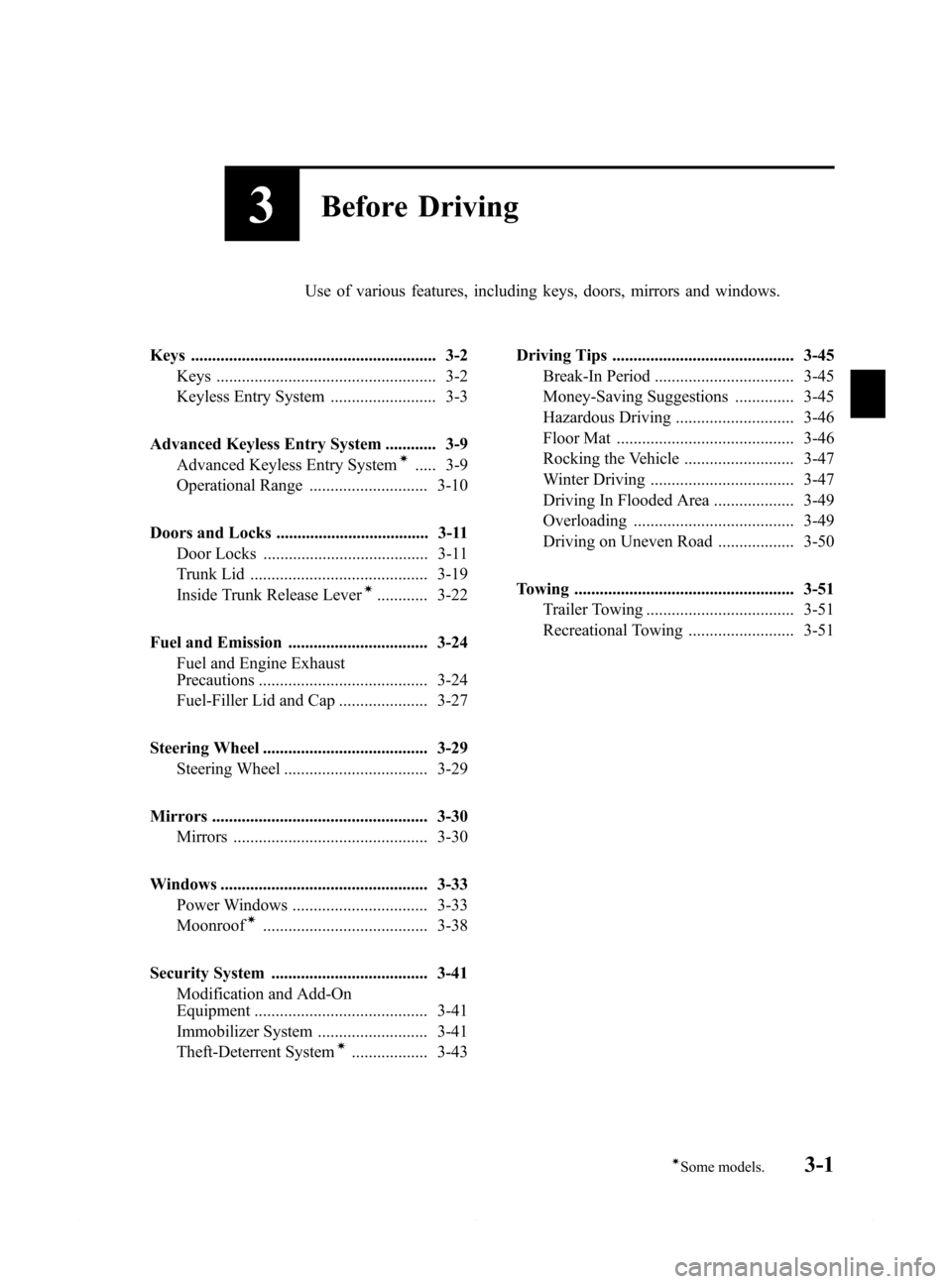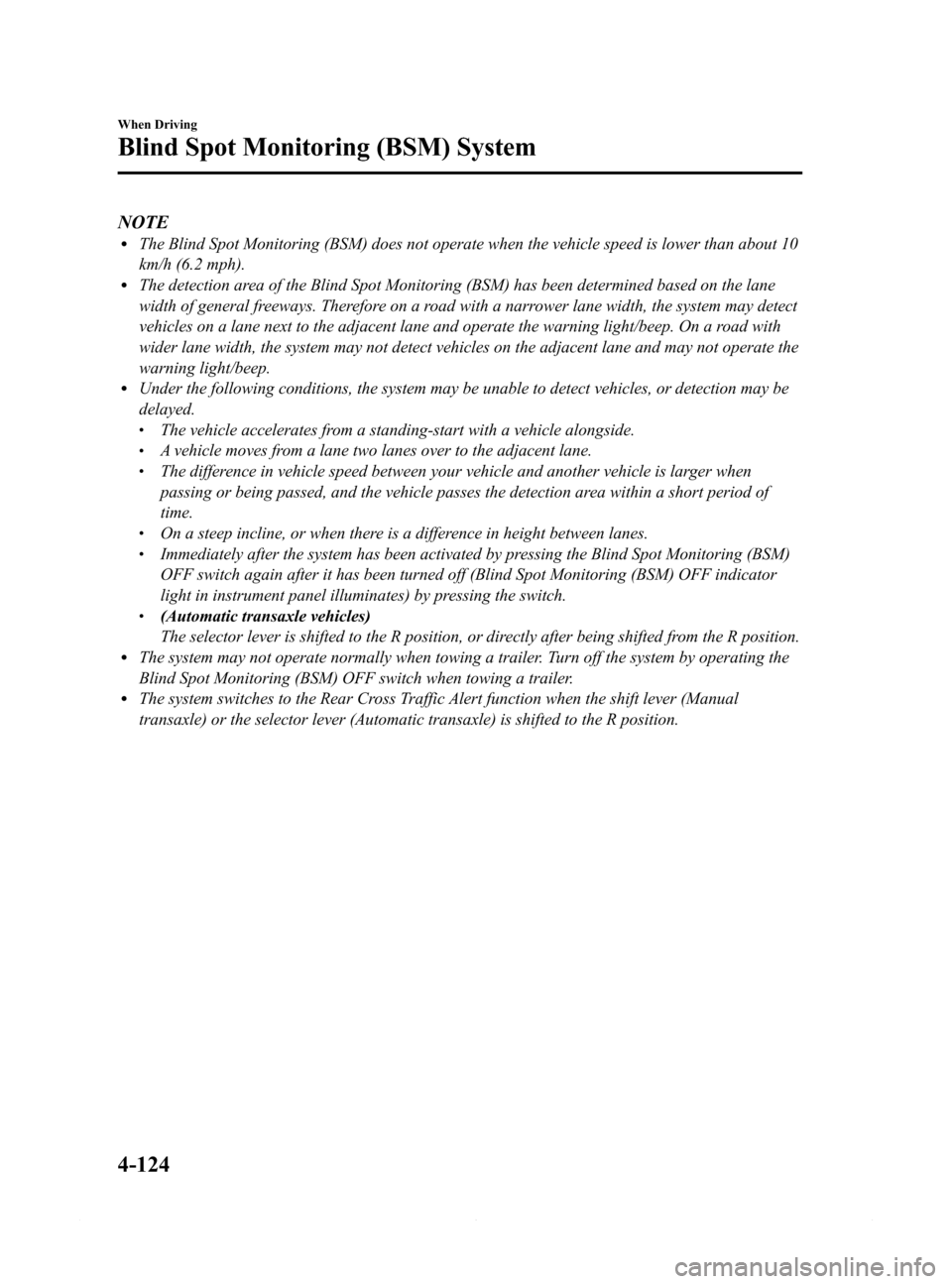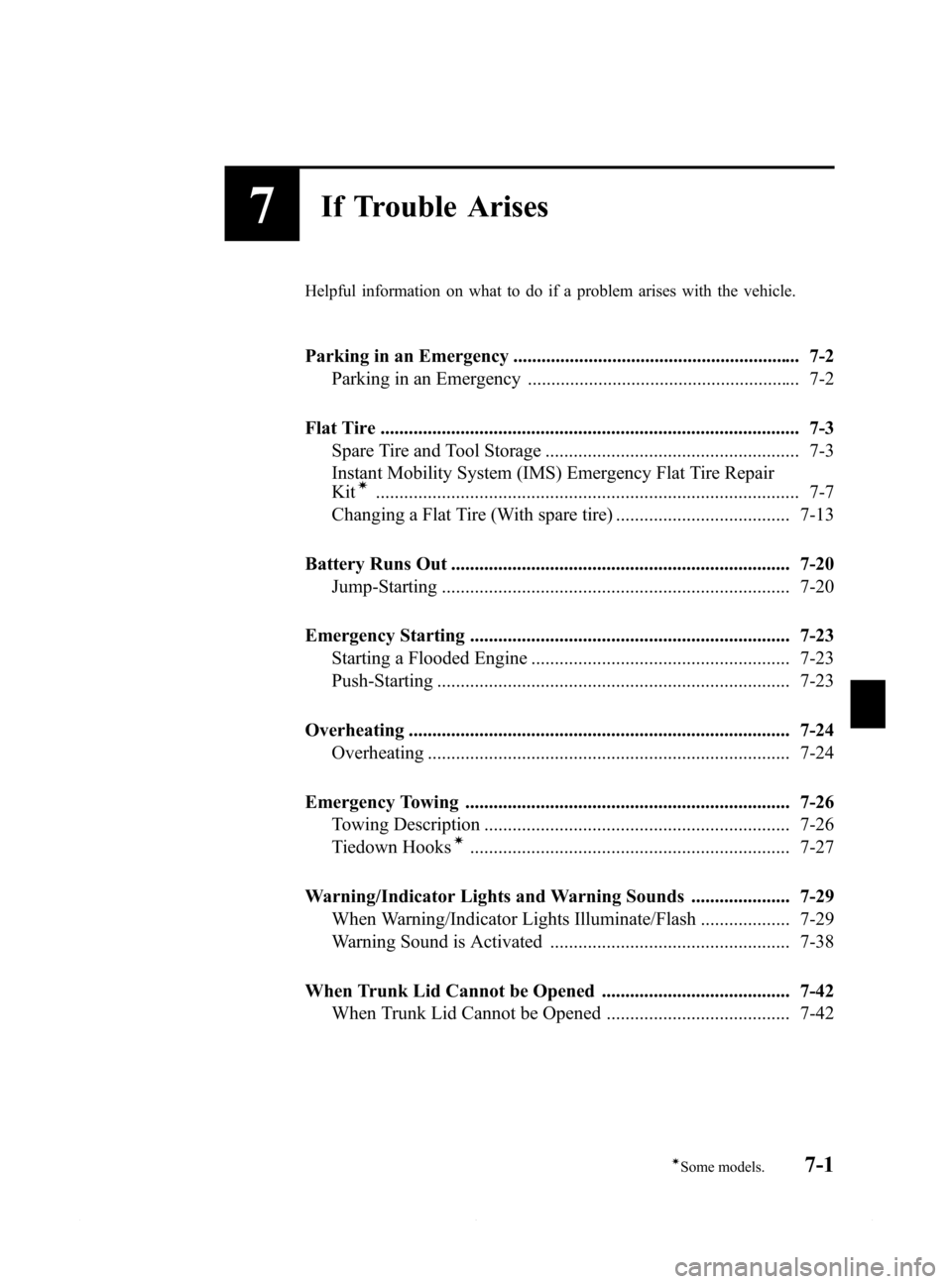towing MAZDA MODEL 6 2014 Owners Manual (in English)
[x] Cancel search | Manufacturer: MAZDA, Model Year: 2014, Model line: MODEL 6, Model: MAZDA MODEL 6 2014Pages: 576, PDF Size: 8.58 MB
Page 73 of 576

Black plate (73,1)
3Before Driving
Use of various features, including keys, doors, mirrors and windows.
Keys .......................................................... 3-2
Keys .................................................... 3-2
Keyless Entry System ......................... 3-3
Advanced Keyless Entry System ............ 3-9
Advanced Keyless Entry System
í..... 3-9
Operational Range ............................ 3-10
Doors and Locks .................................... 3-11
Door Locks ....................................... 3-11
Trunk Lid .......................................... 3-19
Inside Trunk Release Lever
í............ 3-22
Fuel and Emission ................................. 3-24
Fuel and Engine Exhaust
Precautions ........................................ 3-24
Fuel-Filler Lid and Cap ..................... 3-27
Steering Wheel ....................................... 3-29
Steering Wheel .................................. 3-29
Mirrors ................................................... 3-30
Mirrors .............................................. 3-30
Windows ................................................. 3-33
Power Windows ................................ 3-33
Moonroof
í....................................... 3-38
Security System ..................................... 3-41
Modification and Add-On
Equipment ......................................... 3-41
Immobilizer System .......................... 3-41
Theft-Deterrent System
í.................. 3-43Driving Tips ........................................... 3-45
Break-In Period ................................. 3-45
Money-Saving Suggestions .............. 3-45
Hazardous Driving ............................ 3-46
Floor Mat .......................................... 3-46
Rocking the Vehicle .......................... 3-47
Winter Driving .................................. 3-47
Driving In Flooded Area ................... 3-49
Overloading ...................................... 3-49
Driving on Uneven Road .................. 3-50
Towing .................................................... 3-51
Trailer Towing ................................... 3-51
Recreational Towing ......................... 3-51
3-1íSome models.
Mazda6_8DQ8-EA-13L_Edition3 Page73
Friday, June 13 2014 6:21 PM
Form No.8DQ8-EA-13L
Page 123 of 576

Black plate (123,1)
Trailer Towing
Your Mazda is not designed for towing.
Never tow a trailer with your Mazda.
Recreational Towing
An example of“recreational towing”is
towing your vehicle behind a motorhome.
The transaxle is not designed for towing
this vehicle on all 4 wheels.
When doing recreational towing refer to
“Towing Description”(page 7-26) and
“Tiedown Hook”(page 7-27) and
carefully follow the instructions.
Before Driving
Towing
3-51
Mazda6_8DQ8-EA-13L_Edition3 Page123
Friday, June 13 2014 6:21 PM
Form No.8DQ8-EA-13L
Page 208 of 576

Black plate (208,1)
Hill Launch Assist (HLA)
Hill Launch Assist (HLA) is a function
which assists the driver in accelerating
from a stop while on a slope. When the
driver releases the brake pedal and
depresses the accelerator pedal while on a
slope, the function prevents the vehicle
from rolling.
The braking force is maintained
automatically after the brake pedal is
released on a steep grade.
For vehicles with a manual transaxle, Hill
Launch Assist (HLA) operates on a
downward slope when the shift lever is in
the reverse (R) position, and on an
upward slope when the shift lever is in a
position other than the reverse (R)
position.
For vehicles with an automatic transaxle,
Hill Launch Assist (HLA) operates on a
downward slope when the shift lever is in
the reverse (R) position, and on an
upward slope when the shift lever is in a
forward gear.
WARNING
Do not rely completely on Hill Launch
Assist (HLA):
Hill Launch Assist (HLA) is an
auxiliary device for accelerating from
a stop on a slope. The system only
operates for about two seconds and
therefore, relying only on the system,
when accelerating from a stop is
dangerous because the vehicle may
move (roll) unexpectedly and cause
an accident.
The vehicle could roll depending on
the vehicle's load or if it is towing
something. In addition, for vehicles
with a manual transaxle, the vehicle
could still roll depending on how the
clutch pedal or the accelerator pedal
is operated.
Always confirm the safety around the
vehicle before starting to drive the
vehicle.
4-84
When Driving
Brake
Mazda6_8DQ8-EA-13L_Edition3 Page208
Friday, June 13 2014 6:21 PM
Form No.8DQ8-EA-13L
Page 213 of 576

Black plate (213,1)
NOTElThe Smart City Brake Support (SCBS) system will not operate if the driver is deliberately
performing driving operations (accelerator pedal and steering wheel).
lThe Smart City Brake Support (SCBS) system will operate under the following conditions.lThe engine is running.lThe display in the instrument cluster does not indicate that the system requires inspection or it
cannot be used.
lThe vehicle speed is between about 4 to 30 km/h (2 to 18 mph).lThe Smart City Brake Support (SCBS) system is not turned off.lThe DSC operation is not turned off using the DSC OFF switch.lThe DSC is not malfunctioning.lThe Smart City Brake Support (SCBS) detects a vehicle ahead by emitting a near-infrared laser
beam and receiving the beam reflected off the reflector of the vehicle ahead, and then using it for
the measurement. Consequently, the Smart City Brake Support (SCBS) may not operate under the
following conditions:
lReflection of the laser is poor due to the shape of the vehicle ahead.lThe vehicle ahead is significantly dirty.lUnder bad weather condition, such as rain, fog and snow.lThe window washer is being used or the windshield wipers are not used when it's raining.lThe windshield is dirty.lThe steering wheel is turned completely left or right, or the vehicle is accelerated rapidly and
comes close to the vehicle ahead.
lTrucks with low loading platforms and vehicles with an extremely low or high profile.lVehicles with certain shapes such as a vehicle carrier.lUnder the following conditions, the Smart City Brake Support (SCBS) system may not operate
normally.
lHeavy luggage is loaded in the luggage compartment or on the rear seat.lIf there is the possibility of partial contact with a vehicle ahead.lWhen driving on continuously curving roads, and entering and exiting exits.lElongated luggage or cargo is loaded onto installed roof rails and covers the laser sensor.lExhaust gas from the vehicle in front, sand, snow, and water vapor rising from manholes and
grating, and water splashed into the air.
lWhen towing a malfunctioning vehicle.lIn the following cases, the laser sensor may inadvertently determine that there is a vehicle ahead
and the Smart City Brake Support (SCBS) system may operate.
lObjects on the road at the entrance to a curve.lVehicles passing in the opposite lane while making a curve.lMetal objects, bumps, or protruding objects on the road.lWhen passing through a toll gate.lWhen passing under a vinyl curtain or flag.lPlastic objects such as pylons.lTwo-wheeled vehicles, pedestrians, animals or standing trees.lVehicle is driven with some of the tires having significant wear.
When Driving
Brake
4-89
Mazda6_8DQ8-EA-13L_Edition3 Page213
Friday, June 13 2014 6:21 PM
Form No.8DQ8-EA-13L
Page 227 of 576

Black plate (227,1)
WARNING
Do not rely completely on the Mazda Radar Cruise Control (MRCC) system and
always drive carefully:
The Mazda Radar Cruise Control (MRCC) system is designed to reduce load on the
driver, and although it maintains a constant vehicle speed, or specifically, it
maintains a constant distance between your vehicle and the detected vehicle ahead
according to the vehicle speed, the system has detection limitations depending on the
type of vehicle ahead and its conditions, the weather conditions, and the road
conditions. Additionally, the system may be unable to decelerate sufficiently to avoid
hitting the vehicle ahead if the vehicle ahead applies the brakes suddenly or another
vehicle cuts into the driving lane, which could result in an accident. Always verify the
safety of the surrounding area and depress the brake pedal or accelerator pedal
while keeping a safe distance from vehicles ahead or on-coming vehicles.
Do not use the Mazda Radar Cruise Control (MRCC) system in the following locations.
Otherwise, it could lead to an accident:
ØRoads with sharp curves and where vehicle traffic is heavy and there is insufficient
space between vehicles. Roads where frequent and repetitive acceleration and
deceleration occur (Driving under these conditions using the Mazda Radar Cruise
Control (MRCC) system is not possible).
ØWhen entering and exiting interchanges, service areas, and parking areas of
highways (If you exit a highway while headway control is in use, the vehicle
ahead will no longer be tracked and your vehicle may accelerate to the set speed).
ØSlippery roads such as ice or snow-bound roads (The tires could spin causing you
to lose vehicle control).
ØLong descending slopes (to maintain distance between vehicles, the system
automatically and continuously applies the brakes which could result in the loss
of brake power).
For the purposes of safety, switch the Mazda Radar Cruise Control (MRCC) system off
when it is not being used.
CAUTION
If the vehicle is towed or you are towing something, switch the Mazda Radar Cruise
Control (MRCC) system off to prevent a miss-operation.
When Driving
Mazda Radar Cruise Control (MRCC)
4-103
Mazda6_8DQ8-EA-13L_Edition3 Page227
Friday, June 13 2014 6:21 PM
Form No.8DQ8-EA-13L
Page 248 of 576

Black plate (248,1)
NOTElThe Blind Spot Monitoring (BSM) does not operate when the vehicle speed is lower than about 10
km/h (6.2 mph).
lThe detection area of the Blind Spot Monitoring (BSM) has been determined based on the lane
width of general freeways. Therefore on a road with a narrower lane width, the system may detect
vehicles on a lane next to the adjacent lane and operate the warning light/beep. On a road with
wider lane width, the system may not detect vehicles on the adjacent lane and may not operate the
warning light/beep.
lUnder the following conditions, the system may be unable to detect vehicles, or detection may be
delayed.
lThe vehicle accelerates from a standing-start with a vehicle alongside.lA vehicle moves from a lane two lanes over to the adjacent lane.lThe difference in vehicle speed between your vehicle and another vehicle is larger when
passing or being passed, and the vehicle passes the detection area within a short period of
time.
lOn a steep incline, or when there is a difference in height between lanes.lImmediately after the system has been activated by pressing the Blind Spot Monitoring (BSM)
OFF switch again after it has been turned off (Blind Spot Monitoring (BSM) OFF indicator
light in instrument panel illuminates) by pressing the switch.
l(Automatic transaxle vehicles)
The selector lever is shifted to the R position, or directly after being shifted from the R position.
lThe system may not operate normally when towing a trailer. Turn off the system by operating the
Blind Spot Monitoring (BSM) OFF switch when towing a trailer.
lThe system switches to the Rear Cross Traffic Alert function when the shift lever (Manual
transaxle) or the selector lever (Automatic transaxle) is shifted to the R position.
4-124
When Driving
Blind Spot Monitoring (BSM) System
Mazda6_8DQ8-EA-13L_Edition3 Page248
Friday, June 13 2014 6:21 PM
Form No.8DQ8-EA-13L
Page 253 of 576

Black plate (253,1)
qBSM OFF Switch
When the BSM OFF switch is pressed,
the BSM system turns off and the BSM
OFF indicator light illuminates.
Press the BSM OFF switch again to turn
on the BSM system. The BSM OFF
indicator light turns off.
NOTE
lThe system may not operate normally when
towing a trailer. Turn off the system by
operating the BSM OFF switch when
towing a trailer.
lIf the ignition is switched off with the BSM
system turned off, the system becomes
operable automatically when the ignition is
switched ON.
qCare of Radar Sensors
The radar sensors are equipped inside the
rear bumper.
Radar sensors
Always keep the bumper surface near the
radar sensor area clean so that the BSM
system operates normally. Refer to
Exterior Care on page 6-58.
NOTE
lThe BSM OFF indicator light flashes if the
radar sensors cannot operate normally. If
the light remains flashing after cleaning the
bumper surface near the radar sensor area,
consult an Authorized Mazda Dealer.
lFor repairs or paintwork around the radar
sensors, or replacement of the bumper,
consult an Authorized Mazda Dealer.
When Driving
Blind Spot Monitoring (BSM) System
4-129
Mazda6_8DQ8-EA-13L_Edition3 Page253
Friday, June 13 2014 6:21 PM
Form No.8DQ8-EA-13L
Page 461 of 576

Black plate (461,1)
7If Trouble Arises
Helpful information on what to do if a problem arises with the vehicle.
Parking in an Emergency ............................................................. 7-2
Parking in an Emergency .......................................................... 7-2
Flat Tire ......................................................................................... 7-3
Spare Tire and Tool Storage ...................................................... 7-3
Instant Mobility System (IMS) Emergency Flat Tire Repair
Kit
í.......................................................................................... 7-7
Changing a Flat Tire (With spare tire) ..................................... 7-13
Battery Runs Out ........................................................................ 7-20
Jump-Starting .......................................................................... 7-20
Emergency Starting .................................................................... 7-23
Starting a Flooded Engine ....................................................... 7-23
Push-Starting ........................................................................... 7-23
Overheating ................................................................................. 7-24
Overheating ............................................................................. 7-24
Emergency Towing ..................................................................... 7-26
Towing Description ................................................................. 7-26
Tiedown Hooks
í.................................................................... 7-27
Warning/Indicator Lights and Warning Sounds ..................... 7-29
When Warning/Indicator Lights Illuminate/Flash ................... 7-29
Warning Sound is Activated ................................................... 7-38
When Trunk Lid Cannot be Opened ........................................ 7-42
When Trunk Lid Cannot be Opened ....................................... 7-42
7-1íSome models.
Mazda6_8DQ8-EA-13L_Edition3 Page461
Friday, June 13 2014 6:23 PM
Form No.8DQ8-EA-13L
Page 483 of 576

Black plate (483,1)
Starting a Flooded Engine
If the engine fails to start, it may be
flooded (excessive fuel in the engine).
Follow this procedure:
1. If the engine does not start within five
seconds on the first try, wait ten
seconds and try again.
2. Make sure the parking brake is on.
3. Depress the accelerator all the way and
hold it there.
4. Depress the clutch pedal (Manual
transaxle) or the brake pedal
(Automatic transaxle), then press the
push button start. If the engine starts,
release the accelerator immediately
because the engine will suddenly rev
up.
5. If the engine fails to start, crank it
without depressing the accelerator.
If the engine still does not start using the
above procedure, have your vehicle
inspected by an Authorized Mazda
Dealer.
Push-Starting
Do not push-start your Mazda.
WARNING
Never tow a vehicle to start it:
Towing a vehicle to start it is
dangerous. The vehicle being towed
could surge forward when its engine
starts, causing the two vehicles to
collide. The occupants could be
injured.
CAUTION
Do not push-start a vehicle that has
a manual transaxle. It can damage
the emission control system.
NOTE
You cannot start a vehicle with an automatic
transaxle by pushing it.
If Trouble Arises
Emergency Starting
7-23
Mazda6_8DQ8-EA-13L_Edition3 Page483
Friday, June 13 2014 6:23 PM
Form No.8DQ8-EA-13L
Page 486 of 576

Black plate (486,1)
Towing Description
We recommend that towing be done only
by an Authorized Mazda Dealer or a
commercial tow-truck service.
Proper lifting and towing are necessary to
prevent damage to the vehicle.
Government and local laws must be
followed.
A towed vehicle usually should have its
drive wheels (front wheels) off the
ground. If excessive damage or other
conditions prevent this, use wheel dollies.
Wheel dollies
When towing with the rear wheels on the
ground, release the parking brake.
CAUTION
ØDo not tow the vehicle pointed
backward with driving wheels on
the ground. This may cause
internal damage to the transaxle.
ØDo not tow with sling-type
equipment. This could damage
your vehicle. Use wheel-lift or
flatbed equipment.
7-26
If Trouble Arises
Emergency Towing
Mazda6_8DQ8-EA-13L_Edition3 Page486
Friday, June 13 2014 6:23 PM
Form No.8DQ8-EA-13L